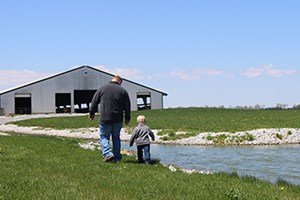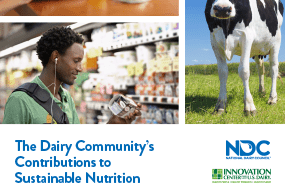Searching for high-quality nutrition with a smaller environmental footprint? Look no further than milk, cheese and yogurt!
The dairy community recognizes that sustainable nutrition is about more than just a carbon footprint. It’s about making positive contributions to alleviate food insecurity, improve community vitality, conserve natural resources and more.
Dairy foods play an important role in sustainable food systems. Ohio and West Virginia dairy farmers are committed to being part of the solution in the health of future generations.
Nourishing People
Affordable, accessible and nutrient-rich foods are vital to nourish a global population. Dairy’s unique nutrient package is hard to replace and is one of the most affordable and accessible ways of getting calcium, vitamin D and potassium — three of the four nutrients most often lacking in Americans’ diets, according to the current Dietary Guidelines for Americans. Dairy foods also contribute high-quality protein and many other essential nutrients, including vitamin A, which is a nutrient of global health concern, to the diet.
Healthy eating patterns, which include low fat or fat free dairy foods, are linked to reduced risk of chronic diseases, including cardiovascular disease and type 2 diabetes in adults, as well as improved bone health, especially in youth.
Nourishing Communities
Did you know that milk is one of the most requested items for food banks? Each year, dairy companies work with local food banks to provide nutritious dairy foods to those in need. In 2022, the U.S. dairy community provided 506 million pounds of dairy to Feeding America, including nutritious milk, cheese and yogurt!
Nourishing the Planet
The dairy community is protecting the planet’s natural resources by advancing sustainable agriculture practices that reduce our environmental footprint.
Due to innovative practices in cow comfort, improved feed and genetics, and modern barn design, the environmental impact of producing a gallon of milk in 2017 shrunk significantly, requiring 30% less water, 21% less land and a 19% smaller carbon footprint than it did in 2007. But that’s not all. The U.S. dairy community accounts for only about 2% of U.S. greenhouse gas emissions and is dedicated to doing more. By 2050, U.S. dairy will achieve greenhouse gas neutrality while improving water use and quality. That’s the vision: dairy as an environmental solution – continuing to develop strategies, technologies and partnerships to accelerate our progress moving forward.
Working together, the dairy community will continue to explore new ways to help nourish a growing population with nutrient-rich dairy foods and ingredients that are affordable and accessible to achieve sustainable nutrition for all — today and for future generations.





